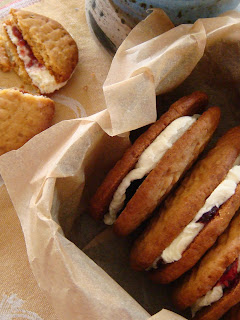Reading the recipe, a hand me down from my partner's great Auntie Rose, there are two problems. I have no honey and no brown sugar. Substitution is necessary. I found a pack of organic panela (evaporated cane juice) hiding behind the dried chillies and a bottle of date syrup kept for squeezing over winter porridge. Add flour (self raising and plain), butter, eggs, vanilla, rosewater, icing sugar, dessicated coconut, berry jam, milk and we're good to go.
As I left the pantry with arms full I knocked a packet of spice mix on the floor. 'Fragrant sweet spices with rose petals', a Herbie's Spices mix. A luscious crush of coriander, cassia, cinnamon, nutmeg, allspice, ginger, poppy seeds, cloves, cardamon and rose petals. This was pure serendipity. The label said, 'an exotic sweet blend to enhance cakes, biscuits, friands and meringues'. I can only think the Kitchen God was giving me a nudge today. In a country made up from a crazy, diverse bunch of people from all corners of the world this sweet blend could represent the ultimate example of culinary and cultural harmony.
Life can always do with a little extra spice and given that I made the berry jam with a hint of rosewater this year this mix of culinary cultures just might work.
Hence we have Monte Carlos with a modern twist for Australia Day. Would Auntie Rose recognise it? I'd like to think that as a great kitchen alchemist herself she'd roll up her sleeves and embrace the change.
Happy Australia Day.
Happy Australia Day.
Monte Carlo Biscuits
190 gms self raising flour, sifted
100 gms plain flour, sifted
1 egg
1 teaspoon vanilla
90 gms brown sugar or panela
2 tablespoons date syrup or honey
30 gms dessicated coconut
1/4 to 1/2 teaspoon fragrant spice mix with rose petals (optional)
raspberry or plum jam
Filling
60 gms softened, unsalted butter
100 gms icing sugar, sifted
1/2 teaspoons vanilla
3 drops rosewater
2 teaspoons milk
Cream butter and sugar till light and fluffy. Add date syrup/honey and cream again until light and well blended. Add egg and vanilla and beat well. Add flour, coconut and spice if using and mix well. Shape generous teaspoons of mixture into ovals, place on a well greased baking tray and press with the back of a fork.
Bake in a moderate oven (350 degrees C) for 10 to 15 minutes. They should be golden brown. Remove and place on a rack to cool.
To make filling cream butter and icing sugar till light and pale. Add vanilla and rose water to milk and gradually add to mixture, beat until well combined.
When biscuits are cool pair them together. Place a teaspoon of butter cream filling and a small teaspoon of jam in the centre of one half the biscuits and gently place remaining halves on top pressing gently.
The panela adds a little crispy, toffee crunch to the biscuit and the touch of spice is perfect. This recipe made 20 monte carlos on Thursday. There were none left by Saturday afternoon. No cook could ask for more!







